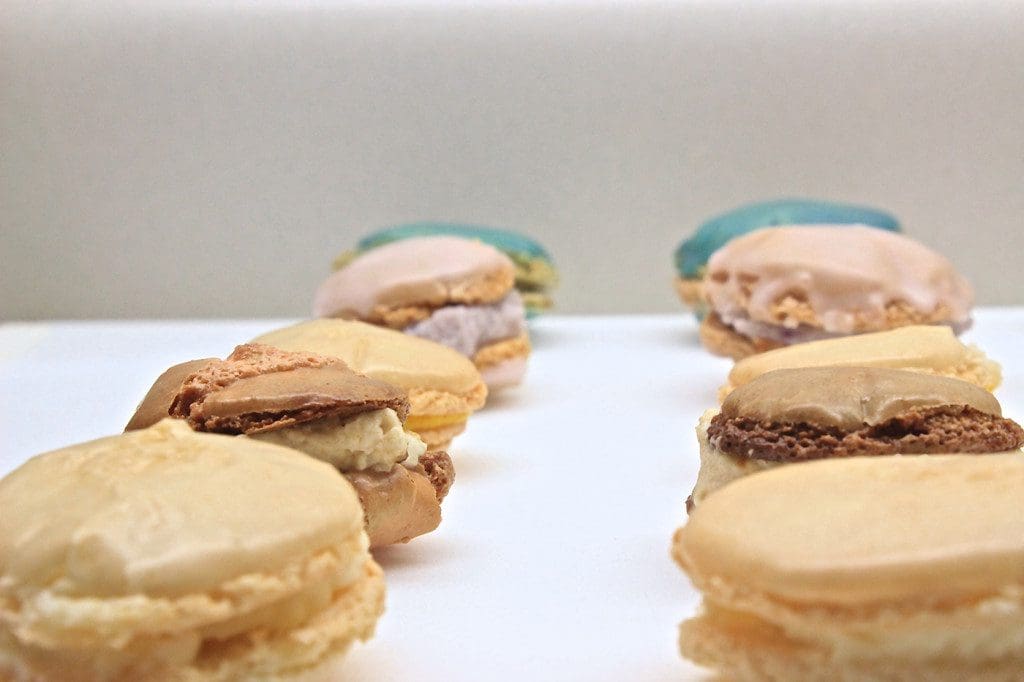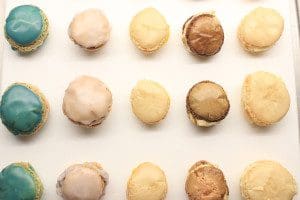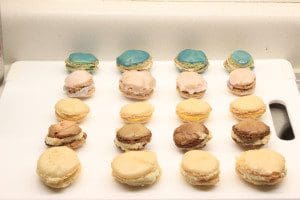Contributed by: Henry Johnson
Boston, MA, April 6th, 2015 – Spring break arrived and I was ready to challenge myself with something I love to eat that’s just for fun, which is when it hit me, like a sweet, little cookie punch; I was going to make French macarons. My name is Henry Johnson, I’m an architectural studies major at Boston University and I absolutely love to cook.
Cooking is fun, and because it requires you to use all of your senses, the creativity that goes into cooking is unparalleled. When it’s time to eat, I find myself appreciating the food that I have just created more than I normally would. And speaking of eating, what is it I cook? It depends on my cravings and if it’s within the monthly budget.
It could be tacos one night, and pad thai the next. But over the course of the school year, the skill I’ve cultivated the most has been baking. Becoming an almost weekly occurrence, I’ve gotten pretty good at it. This year, I’ve made 5 different breads, 2 different brioches, dozens of baked donuts, a few cookies, tarts, and a couple of cakes. None but the first brioche really provided me with a challenge.
I wanted to find a recipe that would really test me, and that’s when it hit me, like a sweet little cookie punch; I was going to make French macarons.
I’m an upperclassman, which means I’ve been given the opportunity to live in my university’s nicer dorms. I have an apartment-style living situation with my own kitchen and private bathroom, and while it’s amazing, I lose out on the one thing many college students rely on; a dining plan. I’ve got to cook for myself every day. Around 90 percent of the time, I enjoy it, but it can create extra stress if I’ve got a large assignment or exam coming up, and even then, it’s probably the part of the day I look forward to the most because of my passion for cooking.
I love to be able to express my creativity in any way possible. I write almost daily, and as an architectural studies major I do a lot of drawing. Despite these being great ways to release creative energy, they don’t come close to the experience of cooking. Cooking is the most creative experience you can have due to its use of all five senses: sight, smell, taste, hearing and touch to create a finished product.
Sight: you have to watch the food to make sure it is all cooked and prepared correctly.
Smell: You have to smell the food, which can clue you in to what to add to a dish or let you know where you are in the cooking process. Smelling is a key component to taste too, after all, the smell of food is what gets your mouth watering. (http://www.brainfacts.org/sensing-thinking-behaving/senses-and-perception/articles/2012/taste-and-smell/)
Taste: The use of taste is obvious in relation to cooking; you have to eat the food and make sure the food is prepared to yours (or whoever’s) liking.
Hearing: Though used less frequently than the other 4, our ability to hear is no less important; how would I know if the oven is done preheating or my food is done baking if I couldn’t hear the beeps of the oven or timer? The sizzle of bacon or the popping of popcorn or hiss of frying food is just as important to the experience of eating those things.
Touch: Lastly, the use of touch. It’s the preferred, albeit painful, way to know if candy is done, and you have to hold your food when you’re preparing it (chopping) or, occasionally, eating it (chicken wings!!).
Spring break arrived and I was ready to challenge myself with something I love to eat that’s just for fun, which is when it hit me, like a sweet, little cookie punch; I was going to make French macarons.
If you don’t know what macarons are, head over to your closest patisserie and ask if they have any, or look them up in Google. They’re little French cookie sandwiches that are filled with a variety of things from butter cream to curd to jam. They’re delicious, light, and it’s nearly impossible to eat just one at a time; I got a box as a Christmas gift and it took a lot of willpower to not eat them all at once.
I knew macarons would be hard to make, but I didn’t know just how hard they would be. I would find out, but I needed some help, so along with my girlfriend, we set off on the challenge to make macarons in my dorm room.
We planned to make 6 different flavors of macarons in celebration of the start of my Spring Break. This project seemed to be the perfect way to start the break. With my limited prior knowledge of what macarons were made of, I knew we needed almond flour, eggs, powdered sugar, and food coloring. Eggs and powdered sugar are staples in my kitchen, so I always have them in stock, meaning I wouldn’t have to buy any. The only things I needed were the almond flour and food coloring, the latter of which surprised me that I didn’t have.
Earlier in our day of preparation, we stopped at a small grocery store in Boston’s South End called Foodie’s. If you think Whole Foods is expensive, try shopping here! Luckily, I have very, very generous parents that pay for my groceries, so out of respect, I don’t like to buy too many things for fear of spending too much money. But 5 things from here cost $55, and while I appreciate that it’s organic, healthy food, $55 is a lot. And it doesn’t help that almond flour is $13 for a one-pound bag. But don’t worry! It’s not only specialty, organic stores that carries almond flour, most general supermarkets/grocery stores carry it too and they may even have it for cheaper.
When we got home from shopping, we did a quick search for macaron recipes and landed upon Martha Stewart’s macaron recipe. And so, we began; I set up shop in my dorm kitchen, a rough, but workable, little area with limited counter space, meaning most of the time when I cook, bowls and boards extend into the dorm’s common room. This project was the most I’ve ever taken over the living space to make food. The counter was piled with bowls filled with different colored batters and my pastry/injector kit I bought from Sur La Table was all strewn about. The dining table would be the final resting place for all of the finished macarons and their filling station. The coffee table was used for drawing circles on the parchment paper as a guide and piping the batter into the circles.
We didn’t have all the right ingredients for buttercream, so instead we filled the macarons with 4 flavors of whipped cream, after realizing that six flavors was more than we could handle; coffee, almond, blueberry, and ginger. This was the only area where we got to play around with the recipe; the recipe is rigid and should be followed strictly, but the fillings and colors are where you get to experiment all you want, so go wild here!
Our final yield, after tossing out the macarons we deemed too imperfect, from uneven cooking or sticking to the parchment paper or breaking, was about 20 macarons. I had one of each and decided to save the rest for later. My girlfriend called me the next day worrying about if we should eat them or not; we did not store them in the refrigerator overnight. Which meant our whipped cream may have gone bad after sitting at room temperature for such a long period of time in a slightly warm dorm room.
With heavy hearts we jointly decided to throw away the remaining macarons; neither of us wanted to run the risk of illness or biting into a rancid cookie. Had my friends not left for spring break, I would have gladly shared the macarons with them the night we finished them, but alas I could not. I felt bad throwing out what I had slaved over, and the worst part was, I barely ate any of them!
Of the many lessons I learned while baking macarons, proper storage and knowledge about what to do with the finished product is now on the top of my list of things to know before I dive into another challenging recipe. Because I never want to throw away delicious food again, after all, I, like all college students watch what I spend on food. And, so you know, the macarons I did eat were unbiasedly and undeniably delicious.
Now for anybody reading this who wants to make macarons, here’s some advice:
- To find almond flour (alternatively called almond meal), look in your supermarket’s baking section and/or organic section; if not in either of those places, ask someone who works there to see if they have any.
- Use an electric hand mixer or stand mixer. Hand-whipping the egg whites to a meringue and the cream to a whipped cream is exhausting and painful. It causes your hand and forearm to tire out and occasionally cramp. Whipping to stiff peaks requires a lot of work.
- Follow the recipe and keep a close watch on the cookies while they’re baking. Cooking will require you to be patient due to: the cookies demand for exact measurements, 2. If done correctly, after the cookies are baked they’re very delicate and can crack if they’re not moved with care and 3. The vibrant color can change or the can burn quickly if you’re not watching them, (something I learned the hard way- red/pink macarons can turn out brown).
- Add what feels like too much color to the batter, most of it will bake out. If you want really vibrant colors, uncomfortably over-color your batter. It will feel wrong, but the end product will be much prettier than sort-of-pink-mostly-gray.
- If you’re a first-time baker, try making baked goods that require similar skills so you can work up to making macarons, as they are very challenging.
- Familiarize yourself first with the different steps in making these. For example, bake some meringues first, make some almond flour cookies.
- Practice making baked goods. That way, you can know some of what to expect when you try these later. Even with practice, there is still the possibility you will mess up, but that’s to be expected.
- Learn from your mistakes with the first ones and fix whatever you think that may have been.
Now go out there and get baking!
Use the same link Henry used to bake his Macarons:
http://www.marthastewart.com/318387/french-macaroons
Follow Henry:
Blog: hhtjohnson.wordpress.com
Instagram: HHTJohnson
Pixieset: http://quixotichalcyon.pixieset.com/foodphotography/


